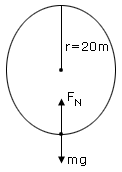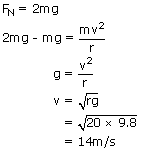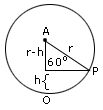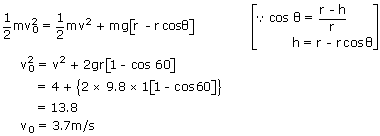A roller coaster at an amusement park has a dip that bottoms out in a vertical circle of radius r. A passenger feels the seat of the car pushing upward on her with a force equal to twice her weight as she goes through the dip. If r = 20m, how fast is the roller coaster traveling at the bottom of the dip?



v = 14 m/s is the velocity of the roller coaster at the bottom of the dip.
A stone of mass 100 gm is suspended from the end of a weightless string of length 1m and is allowed to swing in a vertical plane. The speed of the stone is 2m/s when the string makes an angle of 60° with the vertical. Calculate the tension in the string at θ = 60°. Also find the speed of the stone when it is in the lowest position.

 =
= 
